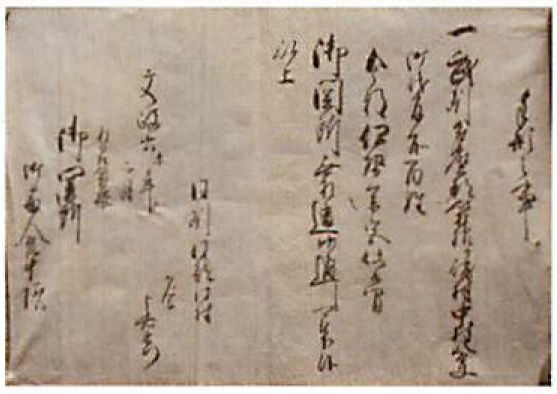 | |
| (箱根ヶ崎村絵図) (Diagram of Hakonegasaki village) | |
 |  |
| (日光人馬差出御免願) (Nikko request to dispatch men and horses) | (通行手形) (Passage license) |
| <所在地 瑞穂町箱根ケ崎> | <Location: Hakonegasaki, Mizuho-machi> |
| 文書のほとんどが江戸期のもので、一部明治期のものを含んでいる。戦後、明治大学の手で整理された際の目録によって順次見ていくと、御用留(ごようどめ)に類するもの118点、廻状(かいじょう)や御触書等が122点、村入用帳をはじめ、御請証文等が295点、村明細書上帳関係文書が10点、届出書等77点、宗門人別帳57点、五人組帳に関するもの47点、戸籍に関するもの105点、次が検地帳関係文書であるが、これは、寛文8年(1668年)1冊、寛文9年(1669年)2冊を含む21点が残されている。続いて、名寄帳(なよせちょう)等、土地関係のもの128点、地租改正に関するもの79点、年貢関係文書285点、産業関係文書26点、頼母子講(たのもしこう)をはじめ、宗教、講関係文書が68点、狭山池及び玉川上水助水、御林山、御伝馬助郷関係文書(ごてんますけごうかんけいもんじょ)227点、御鷹場に関するもの122点、その他214点、合計2011点である。 | Most of these documents are from the Edo period, but some are from the Meiji era as well.After World War II, Meiji University organized these documents. In order, they are: 118 registries of public documents kept at government buildings, 122 publicly circulated documents, 295 vouchers such as village revenue registries, 10 village ledgers, 77 notifications, 57 religious censuses, 47 five-party agreements known as "Goningumicho," and 105 documents related to family registries. There are also a books of land inspections, including one from 1668 and two from 1669.It also includes 128 official real estate deeds and related land documents, 79 documents related to land-tax reform, 285 annual tribute documents, 26 documents related to production, 68 religious and Buddhist lecture-related documents such as mutual financing documents, 227 documents related to the Sayama Pond and Tamagawa aqueduct, forestry, and messenger horse stations, 122 documents related to falconries, and 122 other documents, for a total of 2,011. |
| さらに、状物として、訴訟文書、出入関係の文書、諸届出の文書等の合計が1133点となっているから、総計3144点になる。後者は、瑞穂町史編纂にあたり整理し、仮目録を作成したものである。このほか未整理の文書もあるが、将来整理されるものと思われる。なかでも御用留が、文政11年(1828年)のものから慶応4年(1868年)まで、ほぼそろっていることと、宗門人別帳が文政5年(1822年)より明治4年(1871年)まで、全部揃っていることが特徴である。またこのように、文書の大半が、時代としては、幕末の文化文政以後であり、箱根ヶ崎の名主与右衛門より、為一郎の二代に渡る箱根ヶ崎村及び、その周辺の資料として貴重である。 | In addition, there are 1,133 legal documents, such as litigation documents, revenue and expenditure documents, and notifications, for a grand total of 3,144 documents.The latter of these documents were organized for the Mizuho-machi historical annals, and a provisional inventory of them has been made.There are documents that have yet to be organized, but they will likely be organized in the future.The registries of public documents kept at government buildings for 1828 to 1868 have almost entirely been accounted for, and all of the religious censuses from 1822 to 1871 have been accounted for.As you can see, most of the documents are from the end of the Edo period, from the Bunsei era onwards, and are valuable documents from Hakonegasaki village and its surrounding areas, encompassing the leadership of Hakonegasaki's headman, Yoemon, to Tameichiro II. |